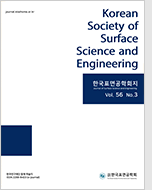
- Past Issues
- e-Submission
-

2021 Impact Factor 1.766
5-Year Impact Factor 1.674
Editorial Office
- +82-2-563-0935
- +82-2-558-2230
- submission@kssse.or.kr
- https://www.kssse.or.kr/

2021 Impact Factor 1.766
5-Year Impact Factor 1.674
The Korean Society of Surface Science and Engineering 2023;56(3):180-184. Published online: Jun, 27, 2023
DOI : 10.5695/JSSE.2023.56.3.180
Scholars have proposed wafer-level bonding and three-dimensional (3D) stacked integrated circuit (IC) and have investigated Cu–Cu bonding to overcome the limitation of Moore’s law. However, information about quantitative Cu–Cu direct-bonding conditions, such as temperature, pressure, and interfacial adhesion energy, is scant. This study determines the optimal temperature and pressure for Cu–Cu bonding by varying the bonding temperature to 100, 150, 200, 250, and 350 ℃ and pressure to 2,303 and 3,087 N/cm2. Various conditions and methods for surface treatment were performed to prevent oxidation of the surface of the sample and remove organic compounds in Cu direct bonding as variables of temperature and pressure. EDX experiments were conducted to confirm chemical information on the bonding characteristics between the substrate and Cu to confirm the bonding mechanism between the substrate and Cu. In addition, after the combination with the change of temperature and pressure variables, UTM measurement was performed to investigate the bond force between the substrate and Cu, and it was confirmed that the bond force increased proportionally as the temperature and pressure increased.
Keywords Cu-to-Cu bonding; 3D stacking; 3D package; C2C; C2W.